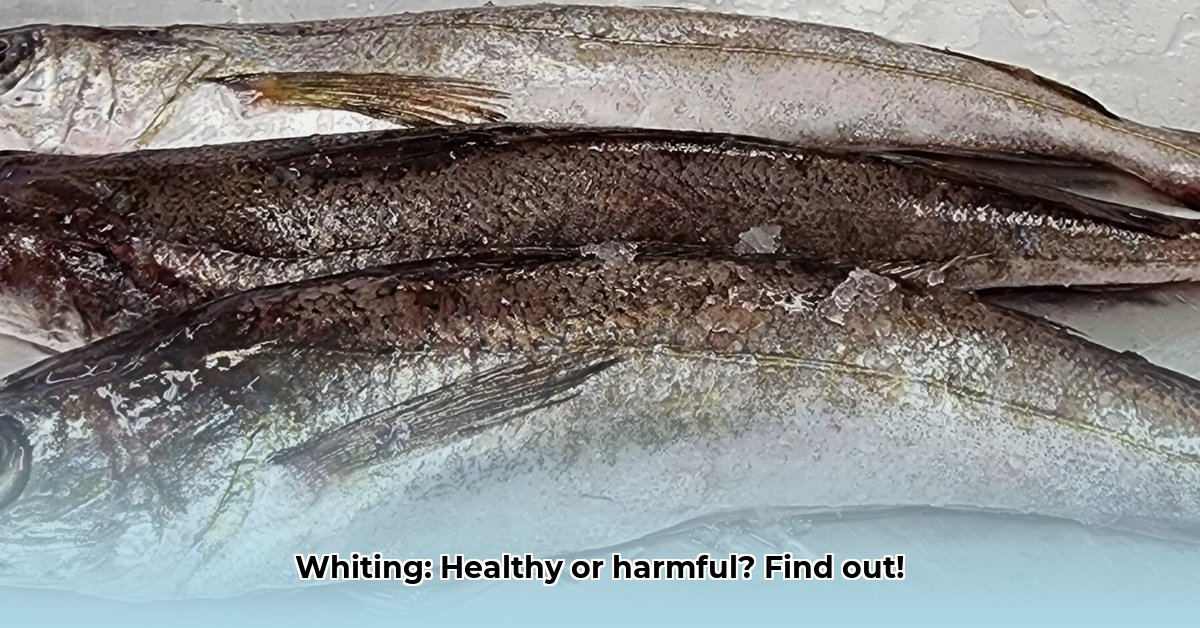Whiting: good for you or not? It’s a question lots of people are asking these days, as this tasty, flaky fish becomes more popular. For comparison, you might also be interested in learning about the nutritional value of other fish. This guide will give you the straight facts about whiting—from its nutritional value and how it stacks up against other fish to the important stuff like mercury levels and how to pick the best quality. We’ll show you how to cook it perfectly and give you some yummy ideas to add it to your meals. Let’s find out if whiting deserves a spot on your dinner plate.
Is Whiting Healthy to Eat? Nutritional Benefits and Potential Risks
So, you’re wondering if whiting is a healthy addition to your diet? It’s a great question, and the answer, like most things about food, isn’t a simple yes or no. Let’s dive in and explore this often-overlooked fish.
Whiting: A Nutritional Profile of Vitamins and Minerals
Whiting is a lean protein powerhouse, meaning it packs a protein punch without a lot of extra fat. Think of it as a friendly fish for your waistline and your health. A typical serving (about 3 ounces) provides a healthy dose of protein – roughly 18 to 24 grams – essential for building and repairing your body’s tissues. We’re talking muscles, bones, and all the good stuff. It’s also a decent source of various vitamins and minerals that contribute to overall well-being. While it’s not a top source of omega-3 fatty acids like salmon, it still offers some, contributing to heart health. Don’t expect it to replace your flaxseed oil, but every little bit helps!
Here’s a snapshot of its nutritional profile (amounts are approximate and may vary slightly):
| Nutrient | Amount per 3 Ounces (Approximate) |
|---|---|
| Calories | 86 |
| Protein | 19 grams |
| Fat | 1 gram |
| Calcium | 44 milligrams |
| Iron | 1 milligram |
| Vitamin C | 1.1 milligrams |
| Vitamin A | 88 IU |
| Selenium | Good source |
| Vitamin B12 | Good source |
| Niacin | Moderate source |
| Magnesium | Moderate source |
| Potassium | Moderate source |
Mercury and Other Environmental Concerns: Ensuring Food Safety
Now, let’s address the important issue of contaminants. The good news is whiting is generally low in mercury, that nasty heavy metal that can be harmful, particularly for pregnant women and young children. This makes it a safer seafood choice compared to some larger, longer-lived fish. According to the FDA, whiting is on the “Best Choices” list for fish low in mercury. This means it’s generally safe to eat two to three servings (8-12 ounces total) a week. However, like all seafood, there’s a small chance of finding other environmental contaminants like PCBs (polychlorinated biphenyls). PCBs were once used in industrial products and are now considered pollutants. The key here is sustainable sourcing. Look for fish from reputable sources that follow responsible fishing practices. Buying from local fishmongers who can tell you about their sourcing can make a big difference. Think of it like buying organic produce—you’re paying a little more for quality and peace of mind.
Weighing the Pros and Cons: Is Whiting Right for You and Your Health?
Let’s break down the benefits and potential drawbacks of including whiting in your diet:
Pros:
- Excellent Protein Source: Provides high-quality protein crucial for muscle growth and repair.
- Low in Fat: A great choice for those watching their fat intake.
- Relatively Low Mercury: Safer than many other fish for pregnant women and young children, falling under the FDA’s “Best Choices” category.
- Versatile in the Kitchen: Easily adapts to various cooking methods and cuisines. You won’t be stuck with just one recipe!
- Often Affordable: A budget-friendly seafood option compared to some of its pricier cousins.
- Good Source of Vitamins and Minerals: Offers essential nutrients like Vitamin B12, selenium, calcium, and iron.
Cons:
- Moderate Omega-3s: While it does contain some, the levels aren’t as high as in some other fatty fish like salmon or mackerel.
- Potential for Other Contaminants: Although low, the risk of PCBs or other contaminants exists, depending on its source and fishing practices.
- Nutrient Variation: The exact nutritional content can fluctuate based on factors like the fish’s size and its environment.
Choosing, Preparing, and Enjoying Whiting: A Step-by-Step Guide for Optimal Health
Here’s how to maximize the benefits and minimize any potential risks while enjoying this delicious fish:
Step 1: Smart Sourcing: Choose sustainably sourced whiting whenever possible. Look for certifications or labels that indicate responsible fishing practices, such as the Marine Stewardship Council (MSC) certification. Ask your fishmonger about the source of their whiting and their fishing practices.
Step 2: Proper Storage: Keep your whiting fresh! Refrigerate it promptly at 40°F (4°C) or below in its original packaging or in an airtight container. Use it within one to two days. Freeze it if you don’t plan to cook it right away.
Step 3: Safe Handling: Wash your hands thoroughly with soap and water for at least 20 seconds before and after handling raw whiting. Use separate cutting boards and utensils for seafood and other foods to prevent cross-contamination. Cook it thoroughly to an internal temperature of 145°F (63°C) to kill any potential bacteria or parasites.
Step 4: Delicious Preparation: Whiting is incredibly versatile! Bake, grill, pan-fry, poach, or steam it. Experiment with herbs, spices, and different sauces to find your favorite way to enjoy it. Avoid overcooking to prevent it from drying out.
Adding Whiting to Your Healthy Eating Plan for Balanced Nutrition
Whiting’s mild flavor pairs well with a variety of ingredients and seasonings. Try it baked with lemon and dill, pan-fried with garlic and ginger, or added to a flavorful curry or stew. It also works wonderfully in tacos or salads for a boost of protein. Get creative and have fun with it! Pair it with whole grains, vegetables, and healthy fats for a complete and balanced meal.
The Bottom Line: Whiting’s Place in Your Diet for Overall Wellness
So, is whiting healthy to eat? The answer is generally yes! It’s a nutritious and usually safe seafood option, providing valuable protein and other nutrients with relatively low mercury levels. However, remember that thoughtful sourcing and safe food handling practices can further improve its health benefits. Enjoy this delicious and versatile fish as part of a balanced diet. And remember, ongoing research continually refines our understanding of food and its impact on health, so stay curious and keep learning!
How to Choose the Safest and Most Nutritious Whiting Fish
Key Takeaways:
- Whiting offers lean protein and essential nutrients.
- Mercury levels are low, making it a safe choice.
- Sustainable sourcing is crucial.
- Cooking methods impact nutrient retention.
- Consider omega-3 levels compared to other fish.
Nutritional Powerhouse: What Essential Nutrients are Present in Whiting?
Whiting is a fantastic source of protein, perfect for building and repairing tissues. It’s also packed with vitamin B12, crucial for nerve function and red blood cell formation. Selenium, another key player, acts as a powerful antioxidant, protecting your cells from damage. Whiting is also a source of magnesium, potassium, and Vitamin B6. While not as rich in omega-3 fatty acids as some other fish, whiting still provides a decent amount—though the exact amount can vary depending on factors like its diet and the environment where it’s caught. Think of it as a reliable, everyday source of essential nutrients.
Mercury Concerns: Is Whiting Safe for Regular Consumption?
The good news? Whiting is generally low in mercury. This makes it a safer option compared to some larger, longer-lived fish that can accumulate higher levels of this heavy metal. The FDA categorizes whiting as a “Best Choice,” recommending 2-3 servings per week. You can breathe easier, but it’s not a free pass. Like all seafood, it might contain trace amounts of other environmental contaminants, including PCBs.
How to choose the safest and most nutritious whiting fish involves buying from reputable sources that prioritize sustainable fishing practices. Look for certifications from organizations committed to responsible aquaculture and wild-caught standards. These certifications offer assurance that the fish have been harvested in a way that protects the environment and ensures fish quality. Check for the Marine Stewardship Council (MSC) label, which indicates that the whiting comes from a sustainable fishery.
Choosing and Preparing Your Catch for a Healthy Meal
Selecting and preparing your whiting correctly is key to maximizing its nutritional value and minimizing any potential risks.
- Selection: Look for firm, moist fillets with a bright, almost pearly appearance. Avoid fillets that smell fishy or have a dull, discolored appearance. The flesh should spring back when touched.
- Storage: Refrigerate properly in an airtight container for
- Weight Loss Supplements That Work and Those That Dont - October 31, 2025
- Male Eating Disorders Often Missed but Increasingly Prevalent - October 29, 2025
- Males With Anorexia Nervosa Have Distinct Symptoms and Treatment Needs - October 28, 2025










